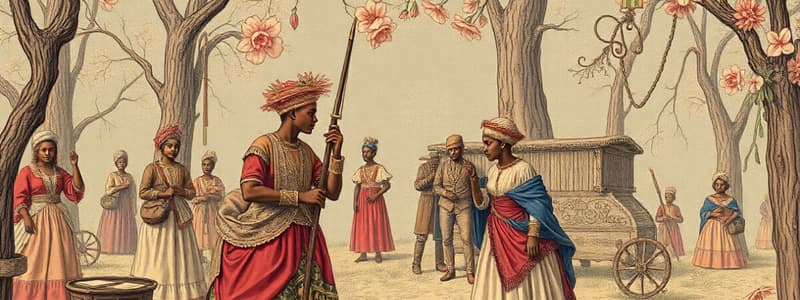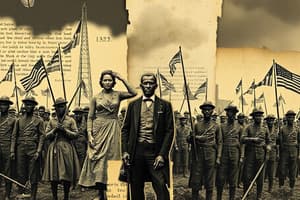Podcast
Questions and Answers
What was a primary economic driver for the Southern states during the mid-19th century?
What was a primary economic driver for the Southern states during the mid-19th century?
- Industrial manufacturing
- Cotton production reliant on slavery (correct)
- Mining for precious metals
- Dairy and livestock farming
Which of the following events was an attempt to maintain a balance of power between free and slave states?
Which of the following events was an attempt to maintain a balance of power between free and slave states?
- The raid on Harper's Ferry
- The Missouri Compromise of 1820 (correct)
- The founding of the Underground Railroad
- The election of Abraham Lincoln
What was the goal of the Abolitionist Movement?
What was the goal of the Abolitionist Movement?
- To end slavery immediately (correct)
- To expand slavery into new territories
- To encourage economic dependency on slavery
- To advocate for gradual emancipation
How did Northern industries relate to the Southern economy?
How did Northern industries relate to the Southern economy?
What significant action did John Brown take in 1859?
What significant action did John Brown take in 1859?
What was the impact of Lincoln's election in 1860 on Southern states?
What was the impact of Lincoln's election in 1860 on Southern states?
Which of the following was NOT a method of opposition to slavery in the North?
Which of the following was NOT a method of opposition to slavery in the North?
What role did Harriet Tubman play in the context of slavery in America?
What role did Harriet Tubman play in the context of slavery in America?
Flashcards
Slavery's impact on the South
Slavery's impact on the South
Slavery was the foundation of the Southern economy and society, driving agriculture and shaping social structures.
Abolitionist Movement
Abolitionist Movement
A movement in the North advocating for the immediate end of slavery due to moral objections.
Sectionalism
Sectionalism
The division of the United States between North and South stemming from distinct lifestyles and beliefs.
Compromise of 1850
Compromise of 1850
Signup and view all the flashcards
John Brown's raid
John Brown's raid
Signup and view all the flashcards
Underground Railroad
Underground Railroad
Signup and view all the flashcards
Abraham Lincoln's election
Abraham Lincoln's election
Signup and view all the flashcards
Confederate States of America
Confederate States of America
Signup and view all the flashcards
Study Notes
The American Civil War: A Nation Divided
- The mid-19th century United States was deeply divided along lines of morality, economics, and geography.
- Slavery and sectionalism were at the heart of this division.
- The North's growing industrial economy contrasted with the South's rural agrarian lifestyle based on slavery.
- Slavery was crucial to the Southern economy, with enslaved Africans working on cotton plantations.
- The South's economic dependence on slavery exacerbated divisions with the North.
- Plantation owners and elites in the South became increasingly dependent on slavery both economically and socially.
- Northern industries were also tied to Southern cotton production, turning raw cotton into textiles sold domestically and internationally.
- The nation's economic prosperity was rooted in the institution of slavery.
- As the 19th century progressed, slavery faced growing opposition in the North.
- Abolitionists challenged the status quo, calling slavery a moral sin and advocating for its immediate abolition.
- The Abolitionist Movement gained momentum through newspapers, public speeches, and other public platforms.
- The path to a future of equality was fraught with political conflicts.
- The clash between pro-slavery and anti-slavery forces intensified as the nation expanded westward.
- New states joining the Union ignited debates about whether they should be admitted as free or slave states.
- The Missouri Compromise of 1820, the Compromise of 1850, and the Kansas-Nebraska Act of 1854 were attempts to maintain a balance of power between the North and South, but ultimately only postponed the inevitable conflict.
- The Abolitionist Movement gained momentum with key figures leading the charge.
- John Brown, a controversial figure, believed in a violent approach to ending slavery.
- His raid on Harper's Ferry in 1859, aimed to incite a slave rebellion, ultimately failed but galvanized anti-slavery sentiment.
- The Underground Railroad, a clandestine network of safe houses and escape routes, played a vital role in helping enslaved individuals reach freedom in the North or Canada.
- Harriet Tubman, its most famous conductor, led many to freedom.
- The election of Abraham Lincoln as president in 1860, a man known for his anti-slavery stance, was the final straw for many Southern states.
- They viewed his election as a threat to their way of life, leading to the secession of seven Southern states and the formation of the Confederate States of America.
- By the mid-19th century, the United States became a nation divided with profound differences that could no longer be reconciled peacefully.
- The stage was set for the American Civil War, a conflict that would test the very foundations of the nation.
- The American Civil War was not a sudden eruption of violence but the culmination of years of economic, social, and political tensions.
- The economic importance of slavery and the opposition from abolitionists created a nation divided, with political conflicts further deepening the divide.
- The Civil War was essentially a war over the soul of America, a battle to determine whether the nation would move toward a future of equality or remain tethered to its past rooted in the institution of slavery.
Studying That Suits You
Use AI to generate personalized quizzes and flashcards to suit your learning preferences.



